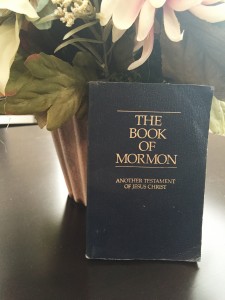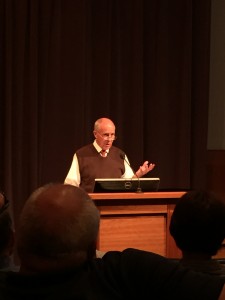Former dean of the College of Biology and Agriculture at BYU Kent Crookston shared his hypothesis on where he believes the record keepers of the Book of Mormon lived. BYU students, faculty and guests gathered on Oct. 6, 2015 to hear about his hypothesis and findings in a lecture he presented at the Harold B. Lee library auditorium.

Crookston explained that while his hypothesis still has many aspects that need to be tested, he has some strong evidence from the text to support and back up his claims. He shared how he has spent the last three or four years studying the Book of Mormon and looking for ecological clues in the scriptures. He said he believes the Book of Mormon record keepers lived in a Mediterranean climate.
He said his interest in the ecology of the Book of Mormon began from reading a few verses from the First Book of Nephi. The verses stated that the record keepers of the Book of Mormon had every kind of fruit and grain. It also mentioned that these seeds were brought from Jerusalem and “did grow exceedingly” in the promised land.
“If [the record keepers] brought seeds and grains of every kind from the land of Jerusalem, where would it be good for [them] to land so that it would grow well?” Crookston said.
He explained that after living in Morocco, a Mediterranean climate similar to that of Jerusalem, he realized that there is a good climate to have seeds and grains grow, and that if they would have lived in a different climate it would have been a different story.
“Almost all of these are a validation of the text. I don’t think Joseph would have thought to write that they have seeds of every kind,” Crookston said.
He continued by explaining how he came up with his hypothesis of where he thinks the exact location might have been. He matched the latitude of where they lived in Jerusalem with that in the Americas. Looking for another Mediterranean climate where the seeds form Jerusalem could flourish, Crookston said he believes that they may have lived somewhere near Baja, California.
There were also many other findings from the Book of Mormon that Crookston believed may back up these claims. Including the mentioning of scare water, unusual forest ecology and separate harvest seasons. He said the Peninsula shape off of Baja at that time would also match many statements found in the scriptures.

Crookston took a trip down to Baja, California to check out the area there and felt that his hypothesis matched up really well with the text.
In the Q&A after his lecture, many in the audience had questions and rebuttals as well as praises for Crookston’s claims. He ended the lecture stating that the exact location of the Book of Mormon people may be something people never find out.
“Maybe we’re not ever supposed to know. This is a sacred text. And it’s an intriguing topic,” Crookston said.




